Lost Gay South Africa: Herb Klein on his new photo book
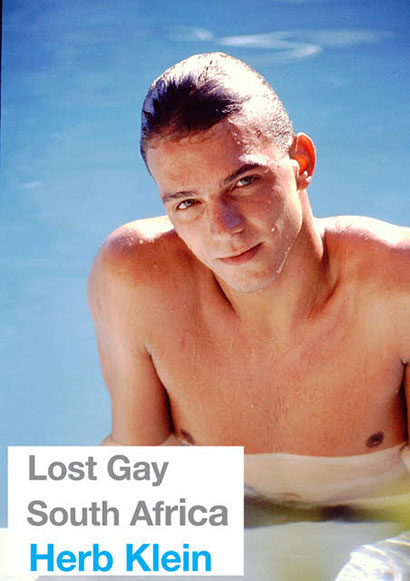 Many South African men over the age of 40 will fondly associate Herb Klein with their sexual awakening back in the dark, pre-internet days of the 1980s.
Many South African men over the age of 40 will fondly associate Herb Klein with their sexual awakening back in the dark, pre-internet days of the 1980s.
At the time, the Zimbabwe-born photographer caused a stir with his Flash magazine; an independent underground publication that featured images of the male form and openly celebrated gay sexuality.
Published under the repressive Apartheid regime, the magazine – which often arrived in the post – was a godsend to the many closeted, repressed and fearful gay men of the day.
When he wasn’t taking pictures of hunky models sans clothes (usually everyday gay and straight men he came across), Klein was always at the ready with his camera at gay clubs and drag shows and pageants.
Among his favourite subjects was the notorious and much-loved Granny Lee. Living first as a male coloured teacher in Kimberley, Lee reinvented herself as a woman who passed as white in Joburg, and became the city’s very own disco granny.
Klein went on live overseas for a time and to produce two adult films in Canada and Argentina and a successful book of his male nudes, South African Sons. He can certainly take a picture: It’s worth noting that one of his images is included alongside those of iconic international photographers in the seminal collection The Male Nude by David Leddick.
Now back in Joburg, Klein has just released a new digital photo book titled Lost Gay South Africa, that brings together many of his historic and never before seen photos.
Lost Gay South Africa is not meant to be a complete or representative history (it primarily explores the white gay community of the time) but offers a glimpse into gay life as seen through Klein’s photo lens.
Mambaonline spoke to the photographer, who is an entertaining storyteller of note, about the Lost Gay South Africa e-book, meeting Quentin Crisp and his many other adventures.
Herb, how did it all start? When did you first get into photography?
I must have been six years old when I first picked up the family’s Kodak box Brownie and started taking family pictures.
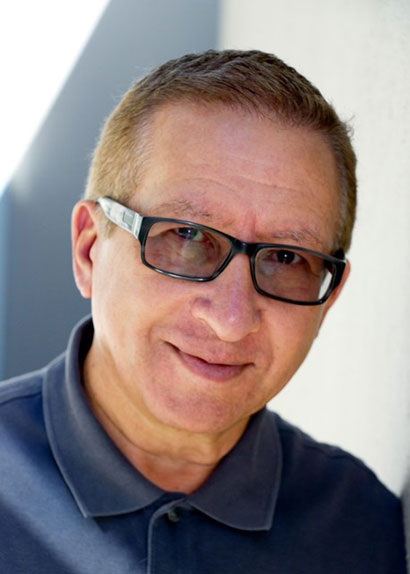
Photographer Herb Klein
What kind of photographer are you?
I suppose you could say that I am an accidental photographer. I am fascinated by light and its effects. I would use that aspect with painting but I am too impatient with the process. A camera gives me the shot in a second. I really enjoy photographing people and part of the skill of that is one needs to make the model comfortable with you. And humour is important. I always use some veiled flattery. I like photographing people because I generally do like people. If you like your subject, subliminally your affection is picked up and they feel important and loved. When one feels that way one generally looks appealing.
Have you been influenced or inspired by any specific photographers?
Bruce Weber and Herb Ritts are two that stand out in my era. Generally any photographer who was able to produce a candid picture with the model captured in the moment. Yousuf Karsh of Ottawa did portraits of major figures and I think that if he lived in the present time his work would be truly amazing as today’s equipment and Photoshop process really enhance images.
How would you describe your new book Lost Gay South Africa?
It’s really the fly on the wall revealing what I had seen during those years; the people and personalities (and, of course, the pretty ones too) of that time, at recreation and leisure. It’s basically me chronicling that era with pictures.
What prompted you compile these images in a digital book?
I started a Facebook group called Lost Gay South Africa. This title echoes the UK group called Lost Gay London. The response was immediate and people saw themselves as they were 25 or 30 years ago and also friends some no longer with us. Of course the current generation of Grindr and other “intimate social media” would never know what it was like before them. Perhaps some of them care enough to know about the journey that brought us to our present experience…
Do you think that SA’s gay and LGBT history has been well documented?
You know, I think that it has to a great extent. Mark Gevisser, Shaun de Waal and several others have done a great job. Of course there are still stories to be told. The black gay community during the Apartheid years had a thriving and interesting underworld which would be very fascinating to read about. Those histories are starting to be told and more will emerge.
How did it come about that you took photos at so many LGBT events at the time?
I had friends who were part of those events who insisted I come to photograph their shows or there were to be hunks (no brainer there) as I was always wanting to find models. David Moolman of Exit and later Gerry Davidson and Henk Botha were friends so I always helped them with content. I gave them free hunky guy photos to spice up the newspaper and I got free ads.
Were you setting out to record history?
Not really. I was having fun and just taking photos as life happened.
How segregated was the gay community back then?
In some instances, liquor licensing laws were so stringent that a business could be raided and closed down if there was “mixing”. Things were better in the 1980s and Granny Lee who reigned supreme in all the venues got away with it. I am sure the police knew of her background as she had been arrested a number of times for enabling prostitution. So they generally looked the other way, so to speak.
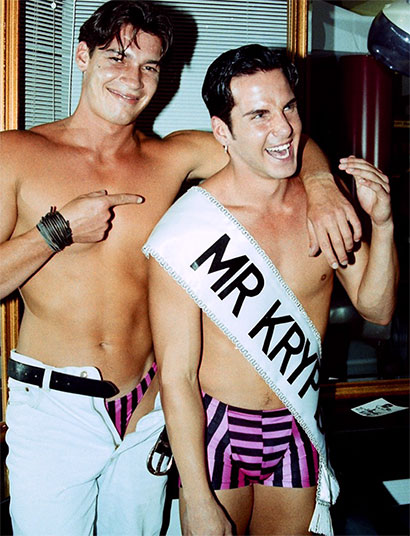
Pic: Herb Klein
Do you have a sense of nostalgia about the gay community then? How do you think it has changed today?
In as much as anyone might remember with nostalgia events of long ago maybe a bit. But we’ve moved on. We have matured and are different people today. Hopefully better. Oscar Wilde once said with reference to gay life: “It was the love that dare not speak its name!” Today it’s the love that will not shut the fuck up!
You’ve also documented gay life in other places like New York City.
My first trip across the Atlantic was in 1977. New York City was amazing and alive. I was there at the tail end of the golden era before AIDS. A Puerto Rican boy who was showing me around told me about Studio 54. We never did make it to Studio 54. (Let’s say that I was side-tracked.) Can you believe that my very first ever night in NYC was in the Ansonia Hotel? Little did I know then that the Continental Baths were in the basement and was one of the hottest tickets in town. Bette Midler started her career there with a skinny Jewish boy with a big nose who played the piano. (Barry Manilow). Then it was the famous New York blackout and the events that happened then. I also lived in Montreal, Canada on and off for over 10 years and made a movie there. I did go to Buenos Aires in Argentina in 2005 and there also made a movie.
Over the years you photographed people like Divine and Sir Ian McKellan. Who was your most memorable famous subject?
[English writer and actor] Quentin Crisp. I ran into him in Manhattan when I went to a gallery showing. I said to him: “How do I get hold of you?” He said: “I’m in the [phone] book.” and he was. At another gallery opening this guy came up to me and said: Hey there’s another English guy over there. Maybe you know him. It was Quentin. Anyway, I would call him up and meet him at the Cooper Diner which was on the lower East side. It was a short walk from his tiny one room apartment. I always paid. We would have long chats about many things. He was a shrewd man and tight with his money. He got invited to a lot of openings and movie screenings. There would be drinks and snacks. Sometimes admirers would invite him to dinner.At the time I was Terry Victor’s room-mate in New Jersey and I asked him if he would lend me his video camera. I wanted to make a short film on Mr. Crisp. All arranged and Terry who worked at a swanky salon in Soho was going to do the make up. So on the appointed day I met and took Quentin Crisp to breakfast. The waitress asked him what he would like to drink. “A large scotch!” was the reply. No liquor licence so it had to be orange juice. I snapped away all the time and occasionally shot footage where he responded to questions. Then by cab off to Terry’s salon and make up and more pictures and more questions until the battery in the camera died.
A lovely day and I took him to a bar and ordered him a large scotch. So I said: “Wouldn’t you like to come to South Africa?” He said: “Would love to but I’m afraid I don’t speak Swahili.” He wrote about my day with him in his last book posthumously published. Quentin Crisp died in England a few months later. One of my portraits of him was on the cover of QX magazine a few days later scooping everybody. My next project is going to be an e-book on that day with Mr. Crisp. Lots of pictures and clips.
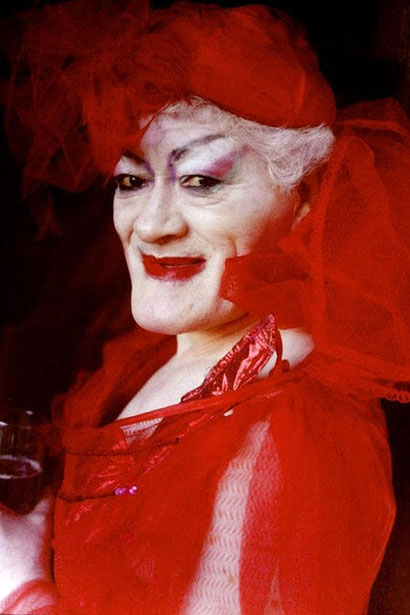
Granny Lee (Pic: Herb Klein)
Anyone else?
Simon Nkoli had a P.O. box an arm’s length away from mine in the Joubert Park Post Office. Many a time we ran into each other and I would get the news of his globe-trotting. I did take pictures of him but sadly they were part of the thousands of negatives which my storage company “lost”.
You’re also effectively the unofficial photographic biographer of Granny Lee. What was she like as a subject? And why were you so interested in her?
Lee was a wonderful subject to photograph. She was a natural and took direction well. I often made suggestions on hats and feathers and she was always game. I was fond of Lee and I knew when I first met her that there was more to this person than the foul mouthed outrageous queen that she was. I used to slip her a few rands at Connections when no-one was looking. I visited her at her boudoir as she called it and used to get outrageous skinner on what she got up to. And yes she did sometimes embellish her history. I don’t for a moment believe that she once played Hamlet at the Drury Lane theatre in London. Her theatre was Mandys and The Dungeon and when she was there it was always showtime. So I do have a lot of material in my book on Granny Lee, including the famous recordings I made a few months before her death.
You will be remembered by many for your Flash magazine. How long did it run for and what inspired you to launch it?
As you know we had a ridiculous law called the Publications Act of 1974 or Obscene publications Act or some such. So I was not able to import anything from overseas. So I decided, well then its time I produced my own magazine with local models. When Flash issue 1 was ready, I went to Champions and handed out a few copies. People lapped it up. Eventually I started putting in very rude Afrikaans stories. I thought it would be erotic but apparently Afrikaans people fell about laughing at the obscene antics of army boys, rugby players and Boere seuns. I have one of those stories in my book. Flash magazine lasted for 11 issues.
Did you have problems with the authorities at the time?
Funny thing, I was never really harassed. Before the Flash magazine days there was unfortunately an envious sociopath in my inner circle who used to regularly make anonymous phone calls to John Vorster Square (Police Headquarters) making outrageous claims. So the cops had to come and raid me. I appeared in court a couple of times to defend myself on charges of possession of obscene materials. I had read the act and it did not clearly define what obscene materials were. So the prosecution were always hoping to get an admission from me that yes the confiscated stuff was obscene. They never got that admission much to their frustration and their case would then fall apart. The magistrate in one case was highly amused at how I handled a rookie prosecutor. Imagine a young Miss Van Breda pulling out a magazine and turning to a page with a close up shot of a huge erection thrusting it in my face and saying: “That’s obscene isn’t it?” So I said: “No it’s not!” “So what is it then?” she asked, now very frustrated. I said, “It looks to me like medical photography and it’s not obscene.” The magistrate said, “Let me see”. I handed it to him. He smiled and tried hard not to laugh. Anyway, it was case dismissed.
What do you most remember about producing Flash magazine?
I always had my phone number in there and I got calls from all over the country. Little dorps where the only open gays were flamboyant hairdressers or florists and I would get a call from a butch rugby player type who had a girlfriend. We would talk about his dilemma. Not only was I fulfilling some basic desires in my audience I was a lifeline to many.
Today, erotic publications have fallen by the wayside in favour of harder online content. What are your thoughts on this?
When something is forbidden people tend to want it. In those days we were not desensitised to erotic material so, when we did come across it, it was more of a rush and exciting. Nowadays kids with smart phones are photographing their genitals and sending the pics everywhere. The days of erotic publications are long gone. There is endless free adult content online, so today it’s no big deal.
You are obviously a fan of the male physique. How did you get into nude photography?
Everybody is a fan of the male physique! Photographing the nude only happened because there was an unfilled niche at the time. So I thought I can do this and I did. I have never put limitations on what could be done because certain people did not think it was possible. So when I needed materials for my audience I just produced it. I used to make photo sets. It started when a man who worked on the mines called me once and said I have someone here you must photograph. So I said OK and they arrived at my apartment and I just drew the curtains and let in the light and improvised. These were nude studies. I then used to get requests from well known South African artists who wanted nude images for reference. Robert Hodgins and Andrew Verster were two notables. Andrew became a friend and he gave me two wonderful paintings of two of the images from my very first photo set.
You published a book of your nudes, South African Sons, some years ago. How was it received and where can one get it?
It was published in 1996 and was a smash hit worldwide. One can still get it online on Ebay and dealers such as Abe Books. I will not be doing a second edition.
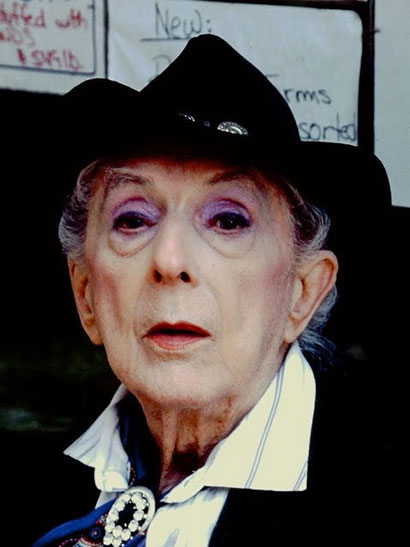
Quentin Crisp (Pic: Herb Klein)
How did you convince so many men (especially straight ones) over the years to take their clothes off for you?
Now that would be telling!
Have any of them come back to you regretting the photos?
Not one!
Why do you think someone should buy Lost Gay South Africa?
For people who lived through those times it is a wonderful memoir of great times, wonderful friends and remembrances of a vibrant social scene. Most of the text was actually written by the people who lived through it all, with comments to the Facebook group. It is a great historical and entertaining record. For the younger generation it shows those early times which paved the way for the hard-won rights and privileges which they today enjoy.
For a unique slice of history, Lost Gay South Africa is a bargain at around R130. It can be downloaded from Amazon.com here. The Kindle viewer app is free to download onto Android, Windows or Apple devices.
Leave a Reply